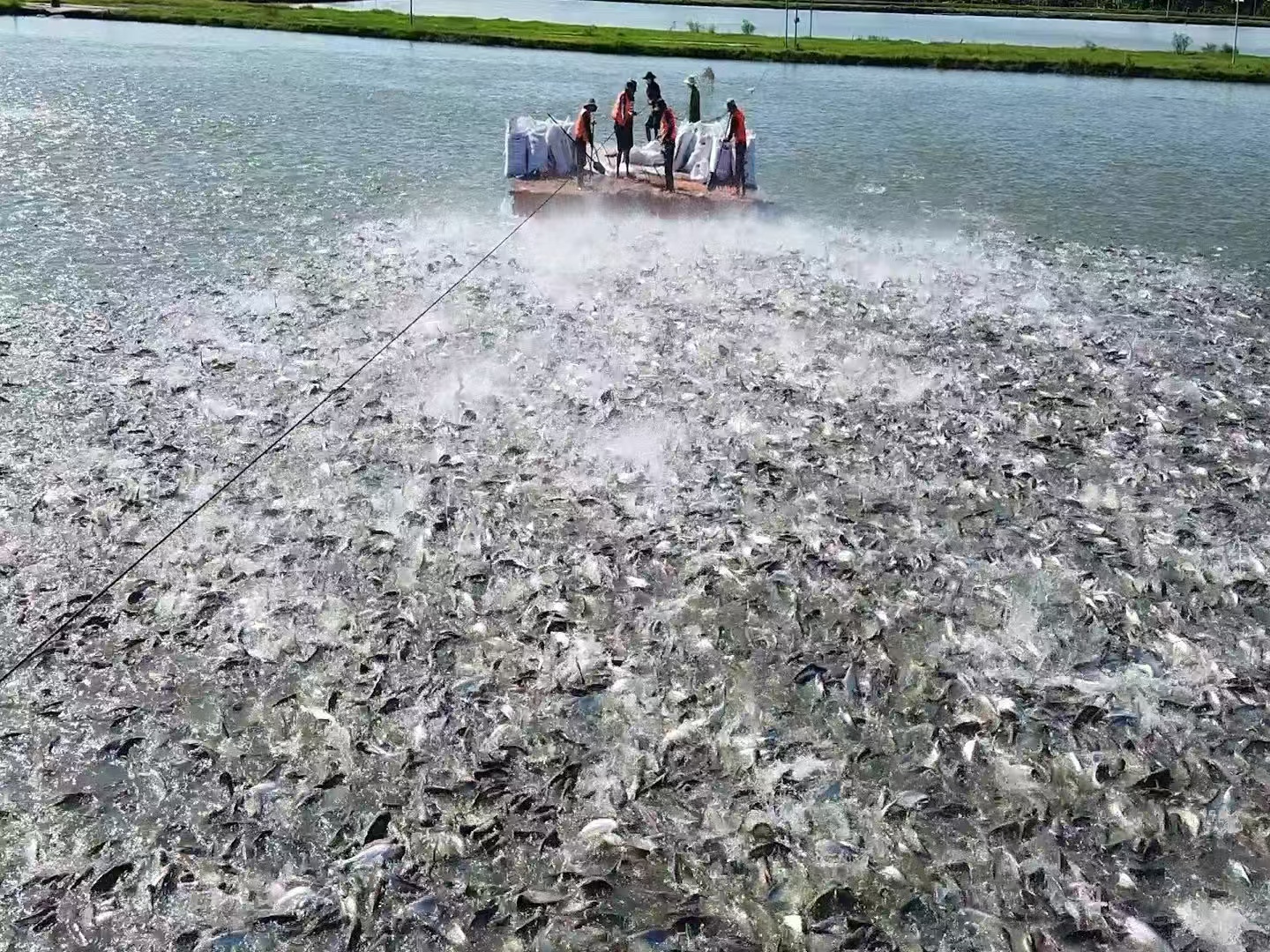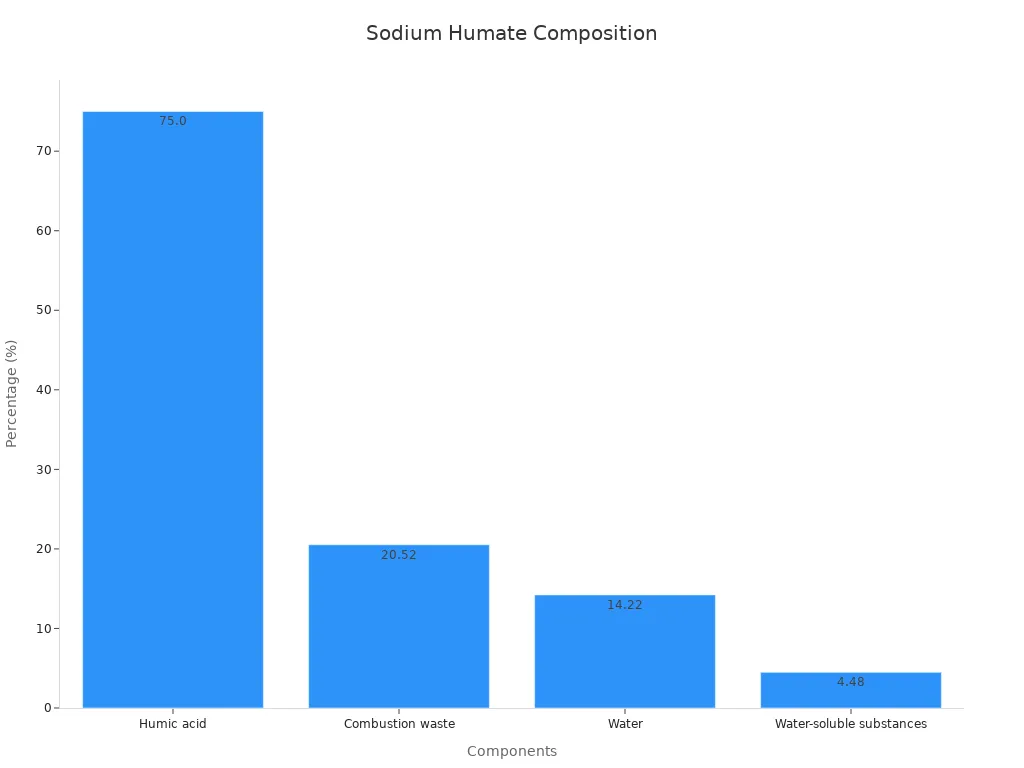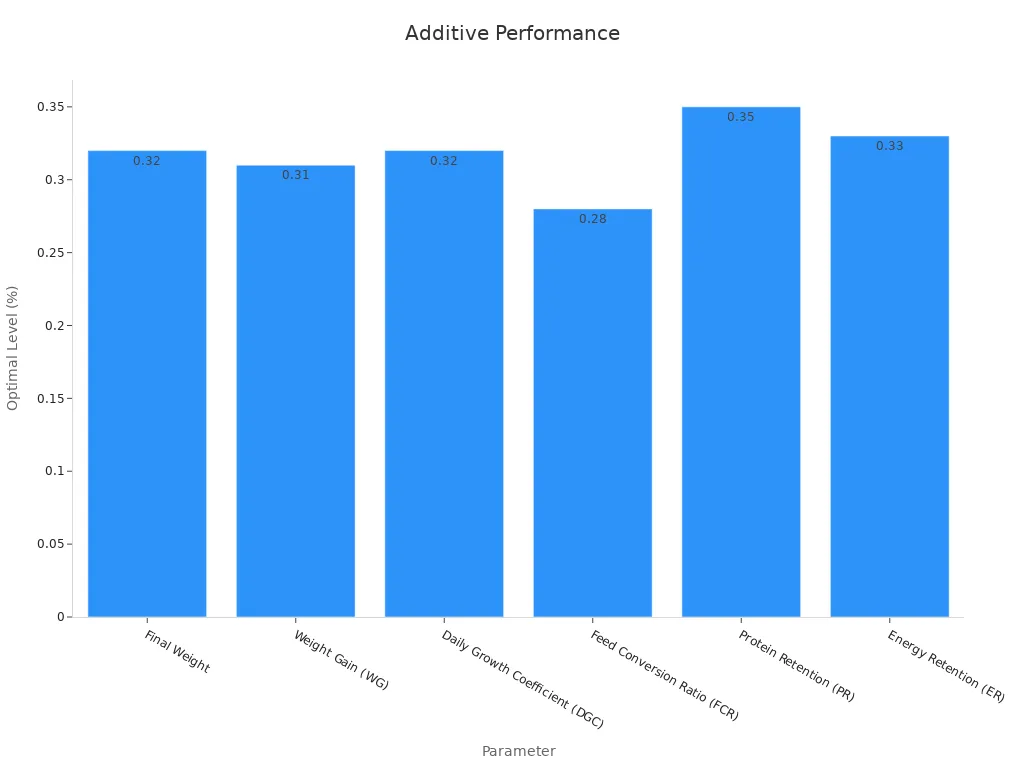Sodium humate for aquaculture or other additives, which works best?

You want your aquaculture system to work well. Many studies say sodium humate for aquaculture works better than other additives. Sodium humate can make water cleaner, help shrimp stay healthy, and help them grow faster. You may see sodium humate removes toxins better than many other additives. Some research says sodium humate also costs less and is safer for the environment. If you want an additive that is safe and works well, sodium humate gives you good results.
Key Takeaways
Sodium humate makes water better by taking out toxins and heavy metals. This helps fish stay healthy and grow faster. Using sodium humate with probiotics helps good bacteria grow in the pond. This makes shrimp stronger and keeps the water cleaner. Sodium humate does not cost much and is simple to use in water or feed. It is safe for the environment and for aquatic animals. Other additives like zeolite, chemical conditioners, and vitamins have special uses. But they may not help shrimp grow as well as sodium humate. Pick additives that fit your farm’s needs. Sodium humate is a smart choice for cleaner water, healthier shrimp, and saving money.
Sodium humate for aquaculture

What is sodium humate?
You might see sodium humate called a natural water or feed additive. Sodium humate is made from humic acid and sodium. It comes from old plants and soil breaking down over time. This compound has many active parts that help water and animal health. You can buy sodium humate as a powder or small grains for aquaculture.
Sodium humate is different from other feed additives because of its chemical makeup. It has about 75% humic acid, 20.52% combustion waste, 14.22% water, and 4.48% things that dissolve in water. It also has alkaloids, vitamins, and other helpful things for animal health and growth.

Main benefits
Sodium humate helps shrimp and other aquatic animals grow and stay healthy. It keeps water clean by grabbing toxins and heavy metals. It also helps shrimp fight off sickness by supporting their immune system. Studies show sodium humate helps white shrimp have more good bacteria in their gut, like Bifidobacterium and Lactobacillus. Using sodium humate can help shrimp grow better and live longer.
Tip: Many farmers pick sodium humate for aquaculture because it is safe, saves money, and is simple to use.
How it works
Sodium humate helps aquaculture in many ways. As a water additive, it grabs harmful things and keeps water clear. As a feed additive, it helps shrimp digest food and get more nutrients. Sodium humate also makes the shrimp’s gut barrier stronger by raising mucin and tight junction proteins. This helps shrimp stay healthy and grow faster. Using sodium humate can make water and animal health better. Many studies show it helps shrimp grow, especially white shrimp.
Other aquaculture additives
Probiotics
Probiotics are good bacteria you can add to water or feed. These bacteria, like Lactobacillus and Enterococcus, help fight bad germs. They also help fish and shrimp digest food better. Probiotics make the immune system stronger. They help animals grow faster. They keep water clean by stopping harmful bacteria. Many studies say probiotics help animals handle stress and get well after sickness. Probiotics are safe and helpful for your aquaculture system.
Zeolite
Zeolite is a natural mineral that helps clean pond water. It grabs heavy metals and ammonia, which can hurt fish. Adding zeolite helps animals grow and keeps them safe from toxins. Research shows zeolite can remove up to 90% of heavy metals. It also helps break down waste and keeps water steady. Some farmers use zeolite with probiotics for better results. You can use zeolite as a main additive to clean water.
Chemical conditioners
Chemical conditioners help fix water quality fast. You might use them to remove sludge or balance pH. One study tested ZSF-Conditioner, a special product. It cleaned sludge quickly and made water safer for fish. Here is a table with some important results:
Aspect | Details |
|---|---|
Cleaning Speed | |
Dewaterability | 74% improvement over other methods |
Environmental Benefit | Greener than traditional chemicals |
Note: Chemical conditioners work well, but you must use them with care. Too much can hurt your animals or the environment.
Vitamins and minerals
Fish and shrimp need enough vitamins and minerals to stay healthy. These nutrients help animals grow, fight disease, and recover from stress. Studies show the right mix helps animals grow faster and live longer. For example, shrimp with balanced vitamins gained up to 25% more weight. They also lived longer. Fish like rainbow trout grew faster and got better after stress. Good feed with vitamins and minerals is important for healthy aquaculture.
Comparison
Water quality
Clean water is important for shrimp ponds. Good water helps shrimp stay healthy and grow. Sodium humate is special because it grabs toxins and heavy metals. This keeps the pond safe for shrimp and other animals. Using sodium humate makes the water clearer and has fewer bad chemicals.
Let’s see how sodium humate compares to other additives:
Parameter | Sodium Humate | Sodium Humate + Probiotics | Control (No Additive) |
|---|---|---|---|
pH | 7.4 - 8.1 | 7.4 - 8.1 | 7.4 - 8.1 |
Ammonia Nitrogen (mg/L) | Peak 2.36 on day 15 | Peak 3.03 on day 15 | |
Nitrite-Nitrogen (mg/L) | Peak 18.61 on day 33 | Peak 17.27 on day 30 | Peak 17.38 on day 30 |
OTU Count (Microbiota) | Higher than control | Highest unique OTUs | Lowest OTUs |
Microbial Diversity | Higher than control | Higher than control | Lower |
Sodium humate lowers ammonia nitrogen more than no additive. If you use sodium humate with probiotics, results get even better. The water has more good bacteria, which helps the pond. Zeolite also removes ammonia and heavy metals. But zeolite does not help good bacteria grow like sodium humate. Chemical conditioners work fast, but you must be careful. Too much can hurt shrimp.
Tip: Sodium humate is a good choice if you want better water and more good bacteria.
Animal health
Healthy shrimp live longer and make more money. Sodium humate helps shrimp fight disease by making their immune system stronger. It also helps the gut barrier, which keeps out bad germs. Studies show pacific white shrimp fed sodium humate have more good gut bacteria, like Bifidobacterium and Lactobacillus. This means less sickness and better health.
Probiotics help by adding good bacteria to water and feed. They make the immune system stronger and help shrimp recover from stress. Some enzyme additives, like glucose oxidase, remove toxins and help the gut. But sodium humate is special because it can grab toxins from water and feed. This gives shrimp extra protection.
Sodium humate: Makes immune system stronger, helps gut, grabs toxins, helps shrimp survive.
Probiotics: Add good bacteria, help immunity, help shrimp recover.
Zeolite: Removes toxins but does not help immunity.
Chemical conditioners: Fix water fast but can stress shrimp.
Vitamins and minerals: Help growth and recovery but do not remove toxins.
Note: Using sodium humate with probiotics can make shrimp even healthier.
Growth rates
You want shrimp to grow fast and reach market size. Good feed, clean water, and strong health help shrimp grow. Sodium humate helps shrimp digest food and get more nutrients. It also makes the gut barrier stronger. This means shrimp get sick less and grow faster.
Here is a table showing how sodium humate helps tilapia grow, which is like shrimp:
Parameter | Effect of Sodium Humate Inclusion | Optimal Inclusion Level (%) |
|---|---|---|
Final Weight | Significant improvement | |
Weight Gain | Significant improvement | ~0.31 |
Daily Growth Coefficient | Significant improvement | ~0.32 |
Feed Conversion Ratio | Improved feed utilization | ~0.28 |
Protein Retention | Improved feed utilization | ~0.35 |
Energy Retention | Improved feed utilization | ~0.33 |

Probiotics can help shrimp grow by making the gut healthier. But how well they work depends on the type and how you use them. Some studies say β-glucan does not help shrimp grow faster but helps with antioxidants. Zeolite and chemical conditioners do not make shrimp grow faster, but they help keep water clean.
Callout: Sodium humate helps shrimp grow better and use less feed, so you save money.
Cost and use
You want something that works well and is not too expensive. Sodium humate usually costs less than other additives. You can use it in water or mix it in feed. It is easy to use and does not need special tools. Many farmers save money with sodium humate because it helps shrimp live and grow, so they can sell more shrimp.
Probiotics can cost more, especially special types. Zeolite is cheap but needs to be replaced often. Chemical conditioners cost more and need careful use. Vitamins and minerals cost extra but are needed for health.
Sodium humate: Cheap, easy to use, works in water and feed.
Probiotics: Cost more, need the right type.
Zeolite: Cheap, needs to be replaced often.
Chemical conditioners: Cost more, need careful use.
Vitamins and minerals: Needed for health, add to cost.
Environmental impact
You want your shrimp farm to be safe for nature. Sodium humate helps by removing toxic metals and bad chemicals from water. It helps clean wastewater and makes soil better. If you use pond sludge as fertilizer, sodium humate helps plants grow. It also binds toxins in soil and lowers bad gas. This keeps the environment safe for future shrimp.
Sodium humate: Removes toxins, helps soil, lowers pollution, safe for long-term use.
Probiotics: Safe for nature, help good bacteria.
Zeolite: Removes heavy metals, safe but does not help soil.
Chemical conditioners: Can hurt nature if used too much.
Vitamins and minerals: Safe if used the right way.
Note: Sodium humate is a good eco-friendly choice for shrimp farms and other aquaculture.
Choosing the best additive
When to use sodium humate
Pick sodium humate if you want better water and healthy shrimp. It works well when your pond has toxins or heavy metals. Sodium humate helps shrimp grow faster and keeps them strong. It makes the gut barrier better. You can add it to water or feed. Many farmers like sodium humate because it is simple and saves money. If you want something safe for nature and good for shrimp, sodium humate is a smart pick.
Tip: Use sodium humate when shrimp are stressed, like after big rain or if water looks bad.
When to use other additives
Other additives help if shrimp need more support. Probiotics are good for adding helpful bacteria to the pond. Zeolite is best for removing ammonia or heavy metals fast. Chemical conditioners fix water problems quickly, but you must be careful. Vitamins and minerals help if shrimp grow slow or look weak. Each additive has its own job, so match the additive to the problem you see.
Key factors
Think about a few things before picking an additive. The type of additive, what your shrimp need, and your farm’s goals matter. Researchers put aquaculture additives into five main groups:
Type | Characteristics | Functions |
|---|---|---|
Technological | Used for things like preservatives and antioxidants | Make food last longer (like adsorbent, antioxidant, preservative) |
Sensory | Used to make food look or taste better | Coloring, flavoring, pigmenting, palatability |
Nutritional | Used to keep or improve nutrition | Vitamins, trace elements, amino acids |
Zootechnical | Used to help animals perform and grow better | Digestives, biota balancers, performance boosters, nutraceuticals |
Anticoccidial | Used to stop coccidiosis | Stops and treats coccidiosis |
You should also think about your farm system, shrimp age, and local rules. Many people care about the environment and food safety now. New things like probiotics and enzymes help with these needs. Government rules tell you which additives you can use. By thinking about these things, you can pick the best additive for your shrimp and your farm.
You can pick from many aquaculture additives. Sodium humate is good for water and shrimp health. It also costs less than some other choices. Probiotics work well too, especially for fish like Cirrhinus mrigala. The table below shows what happens when you use 2 g/kg protexin probiotics:
Parameter | Effect at 2 g/kg Probiotics |
|---|---|
Growth Performance | Significant improvement |
Nutrient Digestibility | Enhanced absorption |
Antioxidant Activity | Increased enzyme activity |
Blood Health | Better hematological indices |
Use sodium humate if you want cleaner water and healthy shrimp. Use probiotics if you want your fish to grow better. Always choose the additive that fits your animals and your farm.
FAQ
What is the best way to add sodium humate to my pond?
You can put sodium humate in water or feed. Most farmers pour it right into the pond. Always read the label to use the right amount.
Can I use sodium humate with probiotics?
Yes, you can use both at the same time. Many studies say using sodium humate and probiotics together makes water better and shrimp healthier. This mix helps good bacteria grow more.
Is sodium humate safe for all types of fish and shrimp?
Sodium humate is safe for most fish and shrimp. You should check the right dose for your animals. Using too much can cause problems, so always measure it carefully.
How often should I use sodium humate in my aquaculture system?
Use sodium humate as often as the label says. Most farms add it every week or after heavy rain. Using it often keeps water clean and animals healthy.
Does sodium humate replace the need for vitamins and minerals?
No, sodium humate does not take the place of vitamins and minerals. Fish and shrimp still need a balanced diet. Sodium humate helps water and health, but you must feed a full diet.
See Also
How Sodium Humate Supports Progress In Agriculture And Industry
Exploring Humate Applications And Their Importance Today
A Guide To Potassium Humate Fertilizer Enhancing Plant Growth
Why Mineral Potassium Humate Fertilizer Boosts Crop Success
Comparing Potassium Fulvate And Humate: Differences And Uses
